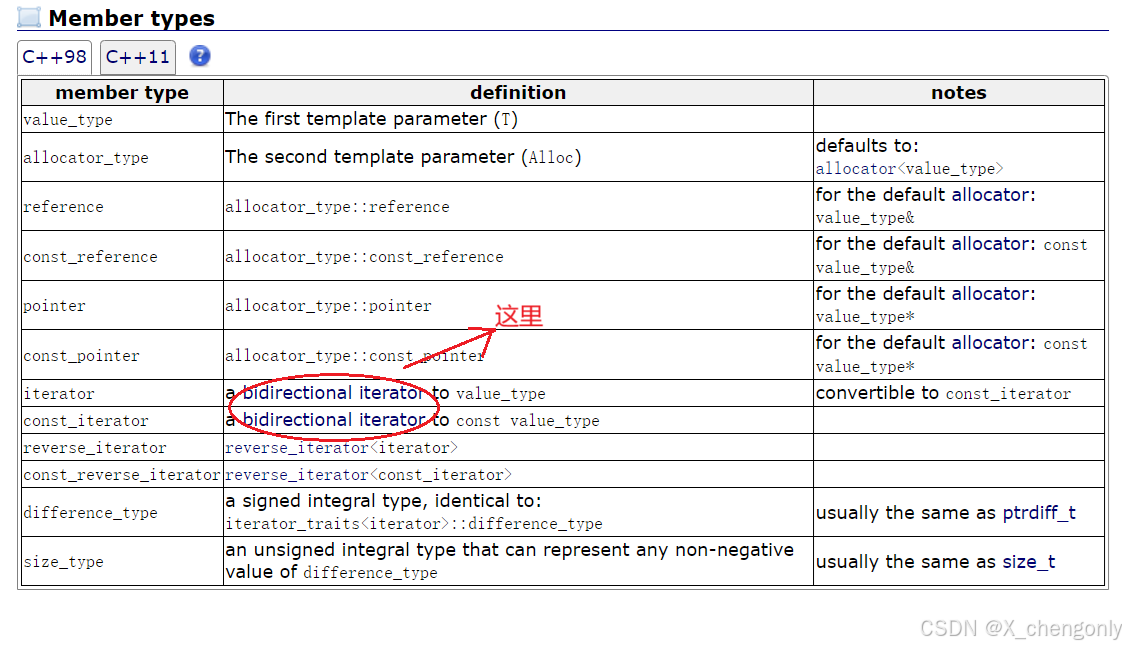OK,最近浅浅学习了STL的list,有兴趣不妨垂阅!

目录
[5. reverse](#5. reverse)
同样的,使用list 需要包含一个头文件<list>。<list>中实现了一个类模板list就是我在本博客想要介绍的!!
那么list到底是个啥?
list是可以在常数范围内在任意位置进行插入和删除的序列式容器,并且该容器可以前后双向迭代,其底层结构是带头(哨兵卫)双向循环链表。举个栗子:

老规矩,我只介绍一些list 常用接口,且我只介绍C++98版本的接口,其他接口可去list文档细细查阅!!
1.constructor

重载了4个构造函数。好像没什么好介绍的,跟vector的构造函数有异曲同工之妙!!
1.explicit list (const allocator_type& alloc = allocator_type())
无参构造。
cpp
#include<list>
using namespace std;
void test()
{
list<int> il;
list<double> dl;
}
int main()
{
test();
return 0;
}2.explicit list (size_type n, const value_type& val = value_type(), const allocator_type& alloc = allocator_type())
构造并初始化n个val。
cpp
#include<list>
#include<iostream>
using namespace std;
void test()
{
list<int> l(5, 6);
for (auto ch : l)
{
cout << ch << ' ';
}
}
int main()
{
test();
return 0;
}
3.template <class InputIterator>
list (InputIterator first, InputIterator last, const allocator_type& alloc = allocator_type())
使用迭代器进行初始化构造,也就是构造并用迭代器区间[first,last)的值(包括*first到*(last-1))初始化。
cpp
#include<list>
#include<vector>
#include<iostream>
using namespace std;
void test()
{
vector<double> v(3, 9.7);
list<double> l(v.begin(), v.end());
for (auto ch : l)
{
cout << ch << ' ';
}
}
int main()
{
test();
return 0;
}
4.list (const list& x)
拷贝构造。
cpp
#include<list>
#include<iostream>
using namespace std;
void test()
{
list<int> l1(5, 6);
list<int> l2 = l1;//调用拷贝构造
for (auto ch : l2)
{
cout << ch << ' ';
}
}
int main()
{
test();
return 0;
}
2.assign
为list容器分配新内容,替换其当前内容,并相应地修改其大小。
1.template <class InputIterator>
void assign (InputIterator first, InputIterator last)
用迭代器区间[first,last)的值来替换list容器原值。
cpp
#include<list>
#include<vector>
#include<iostream>
using namespace std;
void test()
{
vector<char> v(6, 'a');
list<char> l(2, 'b');
l.assign(v.begin(), v.end());
for (auto& ch : l)
{
cout << ch << ' ';
}
}
int main()
{
test();
return 0;
}
2.void assign (size_type n, const value_type& val)
用n个val的值来替换list容器原值。
cpp
#include<list>
#include<iostream>
using namespace std;
void test()
{
list<char> l(2, 'b');
l.assign(5, 'Z');
for (auto& ch : l)
{
cout << ch << ' ';
}
}
int main()
{
test();
return 0;
}
3.insert
看到重载了3个成员函数,其中1个还是函数模板。
均是通过在指定位置的元素之前插入新元素来扩展容器。

我就介绍其中1个:iterator insert (iterator position, const value_type& val)。 在迭代器position指定位置的元素前插入新元素val。返回一个迭代器,该迭代器指向新插入元素。
cpp
#include<list>
#include<iostream>
using namespace std;
void test()
{
list<int> l(8, 0);
auto it = l.begin();
for (int i = 0; i < 4; ++i)
{
it++;
}
it=l.insert(it, 1);
cout << *it << endl;
for (auto ch : l)
{
cout << ch << ' ';
}
}
4.erase
重载了2个函数:iterator erase (iterator position)和iterator erase (iterator first, iterator last)
从列表容器中删除单个元素(位置)或一系列元素([first,last),这有效地减少了被移除的元素数量,从而减小了容器的大小。返回一个迭代器,指向被函数调用擦除的最后一个元素之后的元素。如果操作擦除了序列中的最后一个元素,则这是容器端(end())。
cpp
#include<list>
#include<iostream>
using namespace std;
void test()
{
list<int> l;
l.push_back(1);
l.push_back(2);
l.push_back(3);
l.push_back(4);
auto it = l.erase(l.begin());//iterator erase (iterator position)
cout << *it << endl;
}
int main()
{
test();
return 0;
}
cpp
#include<list>
#include<iostream>
using namespace std;
void test()
{
list<int> l;
l.push_back(1);
l.push_back(2);
l.push_back(3);
l.push_back(4);
auto it = l.erase(l.begin(),--l.end());//iterator erase (iterator first, iterator last)
cout << *it << endl;
}
int main()
{
test();
return 0;
}
5. reverse
反转列表容器中元素的顺序。
这个接口和算法库<algorithm>里面的函数模板reverse使用于list容器来说,功能是一样的。
cpp
#include<list>
#include<iostream>
#include<algorithm>
using namespace std;
void test()
{
list<int> l1;
l1.push_back(1);
l1.push_back(2);
l1.push_back(3);
l1.push_back(4);
list<int> l2(l1);
l1.reverse();//list自带的reverse
reverse(l2.begin(), l2.end());//算法库的reverse
for (auto ch : l1)
{
cout << ch << ' ';
}
cout << endl;
for (auto ch : l2)
{
cout << ch << ' ';
}
}
int main()
{
test();
return 0;
}
6.swap
重载了2个成员函数:void sort()和template <class Compare> void sort (Compare comp)
对列表中的元素进行排序,改变它们在容器中的位置。
其中第1个成员函数void sort()是排升序的,至于另一个成员函数(函数模板)可以实现按需排序,我还不会操作好吧。
cpp
#include<list>
#include<iostream>
using namespace std;
void test()
{
list<int> l1;
l1.push_back(4);
l1.push_back(10);
l1.push_back(5);
l1.push_back(6);
l1.sort();//排升序
for (auto ch : l1)
{
cout << ch << ' ';
}
}
int main()
{
test();
return 0;
}
PS:算法库<algorithm> 里面也有sort,那为什么list内部要实现一个sort呢?
因为算法库的sort不支持排序list容器的数据,为什么不支持,请看小知识部分!
7.merge
这个接口重载有2个成员函数,我就介绍其中这个: void merge (list& x)。这个函数的功能就是将2个均为升序或均为降序的list容器对象合并成1个,合并完后有1个list容器对象就空了。
cpp
#include<list>
#include<iostream>
using namespace std;
void test()
{
list<int> l1;
l1.push_back(1);
list<int> l2;
l2.push_back(9);
l2.push_back(10);
l2.push_back(15);
l1.merge(l2);
cout << "l1: ";
for (auto ch : l1)
{
cout << ch << ' ';
}
cout << endl;
cout << "l2: ";
for (auto ch : l2)
{
cout << ch << ' ';
}
}
int main()
{
test();
return 0;
}
8.unique
这个接口重载有2个成员函数,我就介绍其中这个void unique()。从list容器中每个连续的相等元素组中删除除第一个元素外的所有元素。
cpp
#include<list>
#include<iostream>
using namespace std;
void test()
{
list<int> l;
l.push_back(1);
l.push_back(2);
l.push_back(2);
l.push_back(4);
l.push_back(5);
l.push_back(4);
l.push_back(7);
l.unique();
for (auto ch : l)
{
cout << ch << ' ';
}
}
int main()
{
test();
return 0;
}
所以,如果list对象中,所有相等元素能"挨在一起"的话,例如1个有序list对象,调用了这个接口的话,剩下的元素都是独一无二的,例如:
cpp
#include<list>
#include<iostream>
using namespace std;
void test()
{
list<char> l;
l.push_back('a');
l.push_back('c');
l.push_back('e');
l.push_back('e');
l.push_back('e');
l.push_back('f');
l.push_back('f');
l.unique();
for (auto ch : l)
{
cout << ch << ' ';
}
}
int main()
{
test();
return 0;
}
9.splice
重载了3个成员函数。
1.void splice (iterator position, list& x)
将x的所有元素转移(剪切)到容器中,具体是转移(剪切)到position前。
cpp
#include<list>
#include<iostream>
using namespace std;
void test()
{
list<char> l1(3, 'e');
list<char> l2(3, 'b');
l2.splice(--l2.end(), l1);
for (auto ch : l2)
{
cout << ch << ' ';
}
}
int main()
{
test();
return 0;
}
PS:x和*this可以是同1个 list容器对象,下同。
2.void splice (iterator position, list& x, iterator i)
只将i指向的元素从x转移(剪切)到容器中,具体是转移(剪切)position前。
cpp
#include<list>
#include<iostream>
using namespace std;
void test()
{
list<char> l(3, 'c');
l.push_back('a');
l.splice(l.begin(), l, --l.end());
for (auto ch : l)
{
cout << ch << ' ';
}
}
int main()
{
test();
return 0;
}
3.void splice (iterator position, list& x, iterator first, iterator last)
将范围[first,last)从x转移(剪切)到容器中,具体转移(剪切)到position前。
cpp
#include<list>
#include<iostream>
using namespace std;
void test()
{
list<char> l(3, 'c');
l.push_back('a');
l.splice(l.begin(), l, --l.end(), l.end());
for (auto ch : l)
{
cout << ch << ' ';
}
}
int main()
{
test();
return 0;
}
总的来说,这个接口可以用来:
1.调整当前list对象元素顺序;
2.将1个list对象元素转移(剪切)到另外1个list对象上。
10.小知识
抛砖引玉:
cpp
#include<list>
#include<iostream>
using namespace std;
void test()
{
list<char> l(4, 'c');
auto it = l.begin();
cout << *(it + 3) << endl;
}
int main()
{
test();
return 0;
}
为什么报错呢?

因为list的迭代器属于双向迭代器(bidirectional_iterator)。浅浅介绍一下这些知识:
迭代器按功能来划分可以分为:普通正向迭代器(iterator)、普通反向迭代器(reverse_iterator)、const正向迭代器(const_iterator)、const反向迭代器(const_reverse_iterator)。
迭代器按性质类划分可以分为:单向迭代器(forward_iterator)、双向迭代器(bidirectional_iterator)、随机迭代器(random_access_iterator):
- 单向迭代器(forward_iterator):支持++等操作,不支持--、+、-等操作。forward_list、unordered_map等容器的迭代器都属于单向迭代器。
- 双向迭代器(bidirectional_iterator):支持++、--等操作,不支持+、-等操作。list、map等容器的迭代器都属于双向迭代器。
- 随机迭代器(random_access_iterator):支持++、--、+、-等操作。string、vector等容器的迭代器都属于随机迭代器。
- 其实除了这3种,还引申出了2种抽象的迭代器:只读迭代器(input_iterator)、只写迭代器(output_iterator),这2种迭代器没有哪种容器直接对应它们。

还要明白这些个迭代器的包含关系,如上图:随机迭代器是1种特殊的双向迭代器;双向迭代器是1种特殊的单向迭代器;单向迭代器是1种特殊的只读迭代器 ,亦是1种特殊的只写迭代器。
如何查看某个容器的迭代器性质上归属于哪种迭代器呢?去查询对应的文档就行了。
例如list,看到文档Member types:

那么容器迭代器的性质上归属于哪种迭代器是什么决定的?
......
回答这个问题之前,别忘了迭代器是在模拟指针的行为。
......
是由该容器底层结构实现的。例如:
......
vector底层是顺序表,得益于其底层物理空间是连续的,所以其迭代器可以支持++、--、+、-等操作以达到任意位置的随机访问。
......
list底层是带头双向循环链表,所以其迭代器可以支持++、--等操作,但是不支持+、-等操作,例如其迭代器执行+n操作,无法得到下n个节点的迭代器,因为它们底层物理空间并不连续,固然可以用操作符重载+来实现,但是是不划算的。
......
forward_list底层是单链表,所以其迭代器可以支持++等操作,但是不支持--、+、-等操作。例如其迭代器执行--操作,无法得到上1个节点的迭代器,因为它们底层物理空间并不连续且逻辑上是单向的。
容器迭代器的性质,决定了该容器适用哪些算法。
例如算法库<algorithm>中的sort,看到其重载了2个函数模板,分别是template <class RandomAccessIterator> void sort (RandomAccessIterator first, RandomAccessIterator last)和template <class RandomAccessIterator, class Compare> void sort (RandomAccessIterator first, RandomAccessIterator last, Compare comp)。这里sort函数模板模板参数名字(之一)是RandomAccessiterator,这个名字不是白取的,就是暗示这个算法只能排序其迭代器是随机迭代器的容器的数据。
若某个迭代器是非随机迭代器的容器使用算法库的sort,例如:
cpp
#include<list>
#include<iostream>
#include<algorithm>
using namespace std;
void test()
{
list<int> l(2, 3);
sort(l.begin(), l.end());
}
int main()
{
test();
return 0;
}报错:

若迭代器是随机迭代器的容器使用算法库的sort,例如:
cpp
#include<string>
#include<iostream>
#include<algorithm>
using namespace std;
void test()
{
string s;
s.push_back('a');
s.push_back('e');
s.push_back('b');
s.push_back('g');
sort(s.begin(), s.end());
for (auto ch : s)
{
cout << ch << ' ';
}
}
int main()
{
test();
return 0;
}成功排升序:

造成sort只能排序迭代器是随机迭代器的容器数据的原因在于:sort底层是快速排序,需要迭代器能支持++、--、+、-等操作的,具体的就要去看sort的源代码了。
这就是为什么 算法库的sort不支持排序list容器的数据了。
所以,以后使用算法库的算法时,要搞清楚该容器适合用该算法吗!!!
感谢阅读!